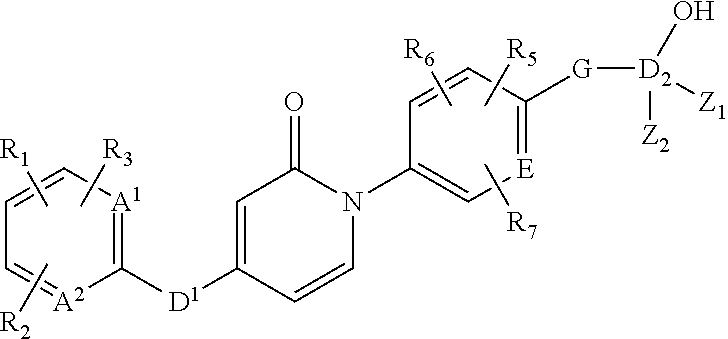Pyridone analogs useful as melanin concentrating hormone receptor-1 antagonists
a technology of melanin concentrating hormone and pyridone, which is applied in the field of pyridone compounds, can solve the problems of increased food intake, weight loss, and decreased feeding in diet-induced obese mi
- Summary
- Abstract
- Description
- Claims
- Application Information
AI Technical Summary
Problems solved by technology
Method used
Image
Examples
examples
[0221]The present invention is illustrated by but not restricted to the examples contained in Tables A-M. The tables also indicate for each example which of nine synthetic methods was employed as well as which of seven analytical methods was utilized. Detailed synthetic procedures as well as analytical HPLC conditions, solvent and column are described in the section after the Tables
TABLE ASyntheticHPLCEx.ProcedureMethodMSNo.StructureUsed(tR Min.)(M + H)NMR DataA-1 #1#6 5.0 min.4301H NMR (CDCl3, 400 MHz) δ 1.36 (s, 6H), 3.86 (2s, 5H), 4.95 (s, 2H), 6.36 (dd, J = 7.0, 1.8 Hz, 1H), 6.78 (s, 1H), 6.84-6.93 (m, 4H), 6.97 (d, J = 8.4 Hz, 1H), 7.26 (d, J = 2.6 Hz, 2H), 7.38 (d, J = 7.0 Hz, 1H).A-2 #2#6 6.0 min.4141H NMR (CDCl3, 400 MHz) δ 1.38 (s, 6H), 2.30 (s, 3H), 3.84 (s, 2H), 4.96 (s, 2H), 6.41 (dd, J = 7.0, 1.8 Hz, 1H), 6.84 (s, 1H), 6.89 (m, 3H), 7.10-7.18 (m, 2H), 7.24-7.31 (m, 2H), 7.39 (d, J = 7.0 Hz, 1H).A-3 #3#6 5.18 min.4421H NMR (CDCl3, 400 MHz) δ 0.24-0.36 (m, 1H), 0.40-0.4...
example a-1
4-((4-Chlorophenoxy)methyl)-1-(4-(2-hydroxy-2-methylpropoxy)-3-methoxyphenyl)pyridin-2(1H)-one
[0229]
A. Methyl 2-oxo-1,2-dihydropyridine-4-carboxylate
[0230]
[0231]To MeOH (80 mL) at 0° C. was slowly added acetyl chloride (20.45 mL, 288 mmol) while stirring. The resulting solution was allowed to warm to RT and stirred for 30 min. To the resulting HCl / MeOH / MeOAc solution was added 2-hydroxyisonicotinic acid (4.00 g, 28.8 mmol) in one portion, and the mixture was stirred at ambient temperature for 16 h. The mixture was concentrated and the residue was stripped from MeOH (10 mL). The crude product was purified by chromatography (silica gel 230-400 mesh, solvent gradient 0-20% MeOH / CH2Cl2) to afford 1A (3.40 g, 22.20 mmol, 77% yield) as a yellow solid. LC-MS, [M+H]+=154.
B. (2-((2-Methoxy-4-(4,4,5,5-tetramethyl-1,3,2-dioxaborolan-2-yl)phenoxy)methoxy)ethyl)trimethylsilane
[0232]
[0233]To a stirred solution of 2-methoxy-4-(4,4,5,5-tetramethyl-1,3,2-dioxaborolan-2-yl)phenol (4.00 g, 15.99 mmol...
example a-2
4((4-Chlorophenoxy)methyl)-1-(4-(2-hydroxy-2-methylpropoxy)-3-methylphenyl)pyridin-2(1H)-one
[0248]
A. Methyl 1-(4-methoxy-3-methylphenyl)-2-oxo-1,2-dihydropyridine-4-carboxylate
[0249]
[0250]To a solution of Part A of Procedure 1 (2.37 g, 15.48 mmol) in CH2Cl2 (20 mL) was added 4-methoxy-3-methylphenylboronic acid (3.85 g, 23.21 mmol), copper (H) acetate (4.22 g, 23.21 mmol), Et3N (4.31 mL, 31.0 mmol), pyridine (2.50 mL, 31.0 mmol) and Molecular Sieves (4 A, 1.5 g). The mixture was stirred at RT overnight and then filtered through Celite. After rinsing the filter cake with 1 / 1 CH2Cl2 / MeOH (200 mL), the combined filtrates were evaporated. Chromatography (silica gel 230-400 mesh, solvent gradient 0-50% EtOAc / Hex followed by 20% MeOH / CH2Cl2) afforded 2A (1.54 g, 5.64 mmol, 36.4% yield) as a yellowish solid. LC-MS, [M+H]+=274.
B. Methyl 1-(4-hydroxy-3-methylphenyl)-2-oxo-1,2-dihydropyridine-4-carboxylate
[0251]
[0252]To a solution of Part A (700 mg, 2.56 mmol) in CH2Cl2 (10 mL) at 0° C. was a...
PUM
| Property | Measurement | Unit |
|---|---|---|
| Wavelength | aaaaa | aaaaa |
| pH | aaaaa | aaaaa |
| humidity | aaaaa | aaaaa |
Abstract
Description
Claims
Application Information
 Login to View More
Login to View More - R&D
- Intellectual Property
- Life Sciences
- Materials
- Tech Scout
- Unparalleled Data Quality
- Higher Quality Content
- 60% Fewer Hallucinations
Browse by: Latest US Patents, China's latest patents, Technical Efficacy Thesaurus, Application Domain, Technology Topic, Popular Technical Reports.
© 2025 PatSnap. All rights reserved.Legal|Privacy policy|Modern Slavery Act Transparency Statement|Sitemap|About US| Contact US: help@patsnap.com



